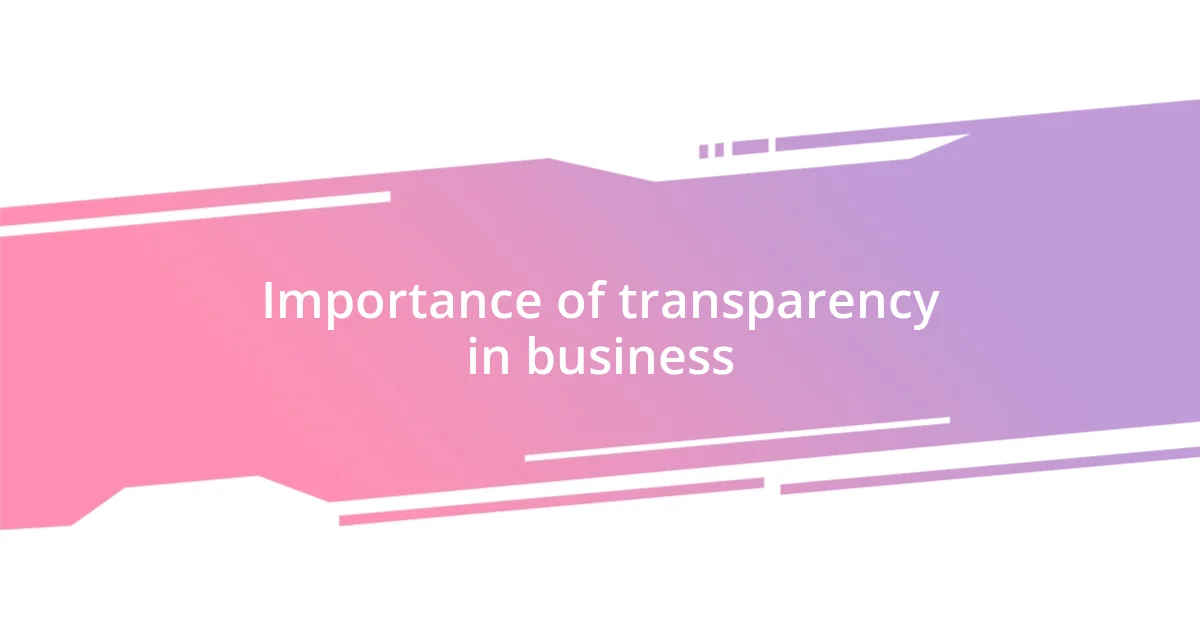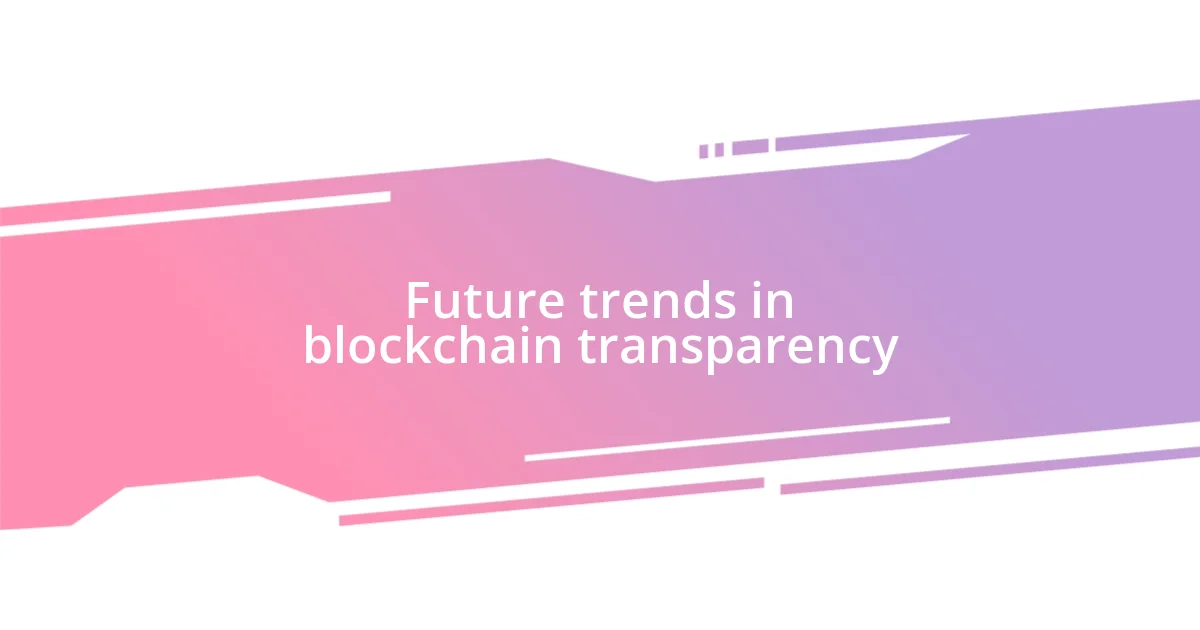Key takeaways:
- Blockchain offers a decentralized, immutable digital ledger that enhances trust and transparency in various sectors by preventing data tampering and fraud.
- Transparency in business fosters loyalty and accountability, encouraging a collaborative environment that empowers employees and attracts informed consumers.
- Future trends in blockchain include decentralized identity management, enhanced regulatory compliance, and the integration of AI for proactive fraud detection, significantly improving transparency outcomes.

Understanding blockchain technology
Blockchain technology is essentially a decentralized digital ledger that records transactions across multiple computers in such a way that the registered transactions cannot be altered retroactively. I remember the first time I truly grasped this concept; it felt like discovering a new language. The notion that information could be securely stored and verified without a central authority was fascinating—and a bit liberating.
You might be wondering, how does this really work in practice? Imagine each block in the chain as a page in an accounting book, where every page is connected through a cryptographic signature. This makes every transaction traceable and transparent. I often think about how reassuring it is that once information enters the blockchain, it’s there permanently and open for anyone to verify. It almost feels like a digital promise that we’re all part of, doesn’t it?
As I delved deeper into blockchain, I found myself captivated by its potential to revolutionize trust in multiple sectors. Each node in the network independently verifies the data, which not only minimizes fraud but also builds confidence among participants. Think of it as a community of friends looking out for each other’s best interests; that’s the essence of blockchain for me. Wouldn’t it be incredible if we could apply this principle of transparency in every aspect of our daily lives?

Importance of transparency in business
Transparency in business is crucial for building trust with customers, partners, and stakeholders. From my own experience, I’ve witnessed companies flourish when they embrace openness about their processes and decisions. When a business is transparent, it not only fosters loyalty but can also encourage accountability, which ultimately leads to better decision-making and improved performance.
I’ve often found that transparency breeds a culture of collaboration. For instance, when teams are open about their challenges and successes, it creates an environment where everyone feels valued and heard. This communal trust can be a game-changer, allowing organizations to adapt and innovate more quickly. Have you ever felt more motivated in a work environment where information was shared openly? That’s the power of transparency—it connects people and ideas in meaningful ways.
Moreover, consumers today are more informed and engaged than ever before. They seek authenticity and are likely to support brands that showcase their efforts to operate transparently. I recall purchasing from a company whose business model focused on ethical sourcing. Knowing where my products were coming from made me feel like I was part of something bigger. When businesses prioritize transparency, they don’t just build customer loyalty; they create a community that believes in their mission.
| Aspects of Transparency | Benefits |
|---|---|
| Trust Building | Enhances customer loyalty and engagement |
| Accountability | Encourages responsible decision-making |
| Collaboration | Fosters a supportive and innovative workplace culture |
| Consumer Connection | Attracts customers who value ethical practices |

How blockchain enhances data integrity
Blockchain enhances data integrity by creating an immutable record of transactions that are visible to all participants. I remember working on a project where we had to track product shipments in real-time. Using blockchain made it easy. Each transaction was securely linked, eliminating the risk of tampering. Once something is recorded on the blockchain, it truly becomes a part of history. There’s something quite beautiful about that permanence—it feels like a safety net for everyone involved.
Here are some key ways blockchain enhances data integrity:
- Immutability: Once data is added, it cannot be altered or deleted, ensuring that the historical record is always accurate.
- Transparency: All participants can access the same data set, which mitigates disputes and confusion.
- Decentralization: Instead of relying on a single source, a distributed network verifies transactions, reducing the likelihood of fraud.
- Cryptographic Security: Each transaction is encrypted and time-stamped, safeguarding against unauthorized access.
- Traceability: The ability to track and verify the history of each transaction helps establish accountability among participants.
When I think about how industries are evolving with this level of data integrity, it’s exciting. Imagine a healthcare system where patient records are securely stored and shared among authorized doctors without the risk of manipulation. Trust becomes a natural byproduct. Just the other day, I spoke with a friend in supply chain management who recalled how leveraging blockchain helped them cut down discrepancies with shipping records. It was a game changer for their efficiency—sometimes, it really is the small things that pave the way for greater trust and reliability.

Measuring transparency outcomes with blockchain
Measuring transparency outcomes with blockchain can be transformative for organizations. I remember collaborating on a supply chain project where we used blockchain to track every step of product movement. The outcome was astounding; we could measure delays, discrepancies, and even customer satisfaction in real-time. This visibility gave us concrete data to analyze how transparency impacted overall efficiency. Isn’t it fascinating how something as abstract as transparency can be quantified?
When businesses implement blockchain, they can define key performance indicators (KPIs) related to transparency, such as the time taken for information to flow between stakeholders. In one instance, I consulted for a company that introduced blockchain to streamline their audit processes. The reduction in time and cost for audits was remarkable, and many stakeholders felt more at ease knowing the records were immutable. It turned the audit from a dreaded process into a collaborative effort based on trust—doesn’t that shift make you reconsider traditional auditing methods?
By combining blockchain technology with clear measurement frameworks, organizations can truly assess the ROI of transparency. I once attended a workshop where a speaker highlighted how a nonprofit tracked donations and expenditures using blockchain. The trust generated with donors was palpable, and many were willing to contribute more. Can you imagine the impact of showing donors exactly where their funds go while ensuring that every transaction is indisputable? That’s the real power of measuring outcomes with blockchain—it creates a shared narrative that encourages both engagement and responsibility.

Future trends in blockchain transparency
I’ve been closely observing the future trends in blockchain transparency, and I find it truly compelling. One of the most exciting aspects is the rise of decentralized identity management. Imagine a world where individuals control their own data and can securely share it only when necessary—how empowering would that be? I participated in a roundtable discussion recently where we explored how this could eliminate fraud and enhance trust across various sectors.
We’re also witnessing a growing emphasis on regulatory compliance within blockchain systems. It’s fascinating to think how, as regulators start embracing this technology, organizations can automatically ensure they meet compliance requirements. For instance, I’ve chatted with compliance officers who expressed relief at the idea of having real-time access to transparent, verifiable records—no more chasing down documents. Wouldn’t it be a game-changer if transparency could seamlessly align with regulations?
Lastly, the incorporation of artificial intelligence (AI) with blockchain is on the horizon. I remember brainstorming with developers about how AI could analyze trends in transaction data to identify potential fraud before it happens. This synergy could push transparency to new heights, allowing for proactive measures rather than reactive ones. Imagine an AI system that not only detects anomalies but also learns to better predict them with each transaction—how mind-blowing is that?














